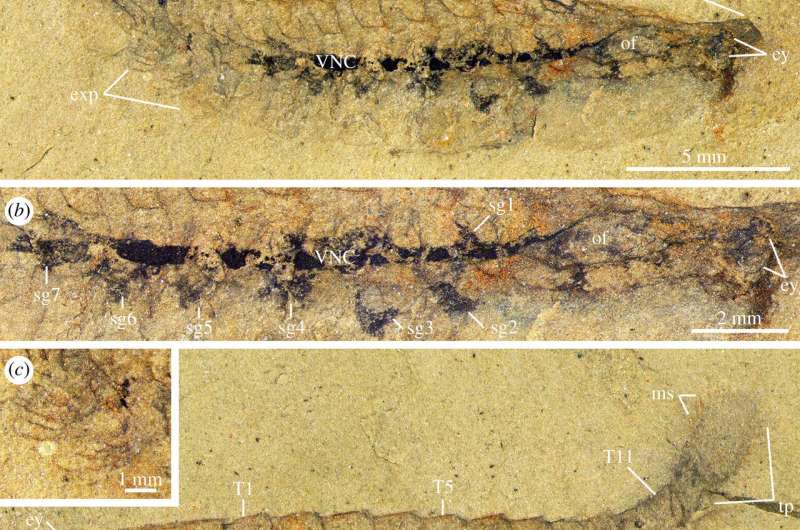Nervous system preservation in Alalcomenaeus sp. from the Stage 4 Pioche Formation. (a) MCZ IP-197956a, part with preserved soft tissues. (b) Detail of CNS in the head and trunk. (c) Detail of trunk exopods with marginal setae. (d) MCZ IP-197956b, counterpart with well-preserved paddle-shaped tailspine and marginal setae. cn, connectives; ey, stalked eye; exp, trunk exopod; hs, head shield; ms, marginal setae; of, oesophageal foramen; sgn, segmental ganglia; Tn, trunk tergites; VNC, ventral nerve cord. Credit: Proceedings of the Royal Society B: Biological Sciences (2019). DOI: 10.1098/rspb.2019.2370
A team of researchers at Harvard University has found what they believe to be evidence of a fossilized arthropod brain. In their paper published in Proceedings of the Royal Society B, the group describes the evidence they found and why they believe it is fossilized neural matter.
It is a widely held belief among archaeologists that soft matter, particularly soft neural matter, cannot become fossilized. Prior research has suggested that such soft material will always be broken down by biological processes before fossilization can take place. But in recent years, several research teams have reported finding what they believe to be fossilized nervous tissue in Cambrian-period arthropods—ancient creatures of the insect, spider and crustacean family. Most such claims have been met with mixed reactions by most in the archaeology community. In this new effort, the researchers report evidence of neuroglial matter in a fossilized arthropod from the Cambrian period.
The specimen found by the team at a site in Utah is known as an Alalcomenaeus, a tiny creature that has been known to fossilize well due to its tough exoskeleton. Generally, evidence of any soft tissue in such finds has not been found. But the new find had what the researchers describe as symmetrical stains along the middle part of the creature which, they noted, resembled part of the central nervous system in modern arthropods.
During testing, they found that the stain had traces of carbon, which, the researchers note, is found in abundance in nervous tissue. They also found during tracing of the path of the stain that it met with the creature's four eyes, suggesting nerve tissue. The researchers claim such evidence is enough to conclude that the stain they found in the Alalcomenaeus is fossilized neural matter—evidence of the fossilization of soft tissue.
As a further test, the researchers examined a second fossilized Alalcomenaeus that had been found in the same part of Utah. They report that the second specimen had stains very similar to the first. They also report that a team in China had found a specimen in China with nearly identical stains that was recovered from a site very simile to the one in Utah. The researchers suggest the unique conditions might be the reason that all three specimens have what appears to be fossilized neural tissue.
More information: Javier Ortega-Hernández et al. Proclivity of nervous system preservation in Cambrian Burgess Shale-type deposits, Proceedings of the Royal Society B: Biological Sciences (2019). DOI: 10.1098/rspb.2019.2370
Journal information: Proceedings of the Royal Society B
© 2019 Science X Network
























